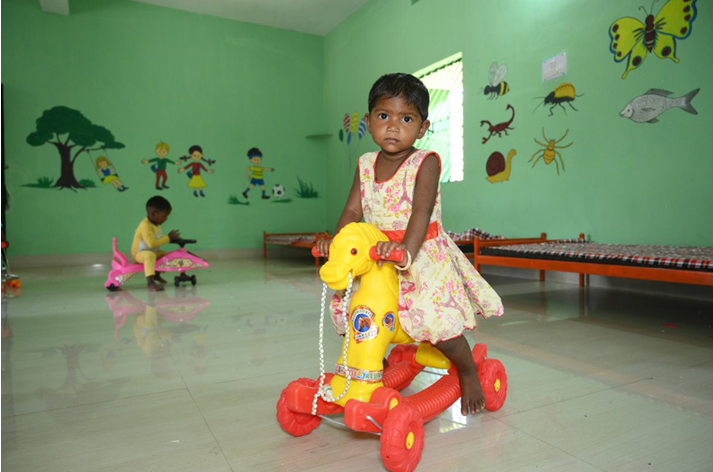
Malnutrition is one of the significant challenges in the mining affected areas of Odisha. When malnutrition occurs in early childhood, it leads to poor intellectual and cognitive development, which is likely to have its effect throughout one’s life. This results in poor working capacity that affects their earning capacity, thus keeping them in a poverty trap. Further, under-nourished girls grow into weak mothers, thus maintaining the vicious cycle of poverty and ill health.
Anganwadi Centres (AWC) across the state has been operationalized under the ICDS programme; one function of this program is to provide supplementary nutrition to preschool children. However, children below 3 years of age (the period when malnutrition sets in) are not looked after In the Anganwadi centers. The mother or the family is handed over the Take Home Ration (THR) meant for the under-3 children once a week or fortnight. Further, with inadequate community engagement and participation, the demand for ICDS services continues to remain low. Another area of concern is the poor childcare practices in rural and tribal areas, where women often have to work hard in order to support the household economy, leaving little time to take care of their children. This situation Is exacerbated In Sundargarh, especially in the mining affected villages where young mothers have to leave behind their infants to do hard labour in the mines. Under-3 children are the most vulnerable because of the following problems:
- They cannot feed themselves
- No one to feed them frequently as parents are daily wage earners
- Extreme poverty, lack of purchasing capacity of parents
- Lack of knowledge of caregivers — poor quality of food, low frequency of feeding
One of the possible solutions to address these gaps could be establishment of day care centers or crèches. This would establish an overall environment where interventions related to nutrition and health will be able to make an impact on malnutrition. Poor women spend much time and energy working for wages, doing housework, working on land-holdings and looking after cattle. It is in this context that the crèche model is found to be suitable to provide this environment where malnutrition can be tackled.
Objective
A crèche is a community centre where mothers leave their children when they are at work. The crèches provide day care services for children for eight hours a day for 6 days in a week. The timings for the Crèches will be decided for each village with respect to the work timings of the mothers in consultation with the community. Crèches primarily serve children between 6 months to 3 years of age.
Project objectives (with respect to the children of the age group 6 months — 3 years in the project area):
- Ensure no child in the age group of 6 months — 3 years is malnourished as measured by underweight, stunting and wasting in the project area by the end of the first year
- Ensure 100% coverage of essential nutrition services like iron supplementation, Vitamin A supplementation, deworming, optimum complementary feeding practices with respect to initiation, frequency and diversity.
- Halve preventable infant deaths in the age group of 6 months – 3 years by the end of the first year and completely eliminate it by the end of the second year
- Achieve 100 percent growth monitoring, immunization and health check-up by the end of second year through robust linkage to Anganwadi and Village Health and Nutrition Day (VHND)
- Ensure that all the children in the crèche are adequately exposed to stimulation and cognitive development
- Ensure that all kinds of diseases, disability and growth faltering amongst the children In the crèche are detected early and quick intervention is taken up
- Ensure through community meetings and counselling that no child in the age group of 0 3 years in the project area is subjected to any sort of superstitious practices such as hot iron branding, etc
Services provided in the crèche:
1. Childcare facilities to house interventions of nutrition and health
- Growth monitoring and age appropriate physical and cognitive developmental milestones
- Record, report and action towards growth faltering
- Safety and hygienic environment
- Early Childhood Care and Development (ECCD) Care and stimulation
2. Adequate and quality food for children.
- Complementary feeding for 6 months — 3 years with dietary diversity
- All children with malnutrition get locally produced calorie dense, protein rich food
3. Disease prevention, treatment and rehabilitation
- Prevention
- Early identification of growth faltering and under nutrition
- Mobilization and community awareness towards immunization and Village Health and Nutrition Day (VHND)
- Convergence between AWW, ANM (ICDS and NRHM) and other frontline health workers to identify and refer the severe acute malnourished children to Nutrition Rehabilitation Center (NRC) and follow up of discharged SAM children.
Donor: District Mineral Foundation, Sundargarh
